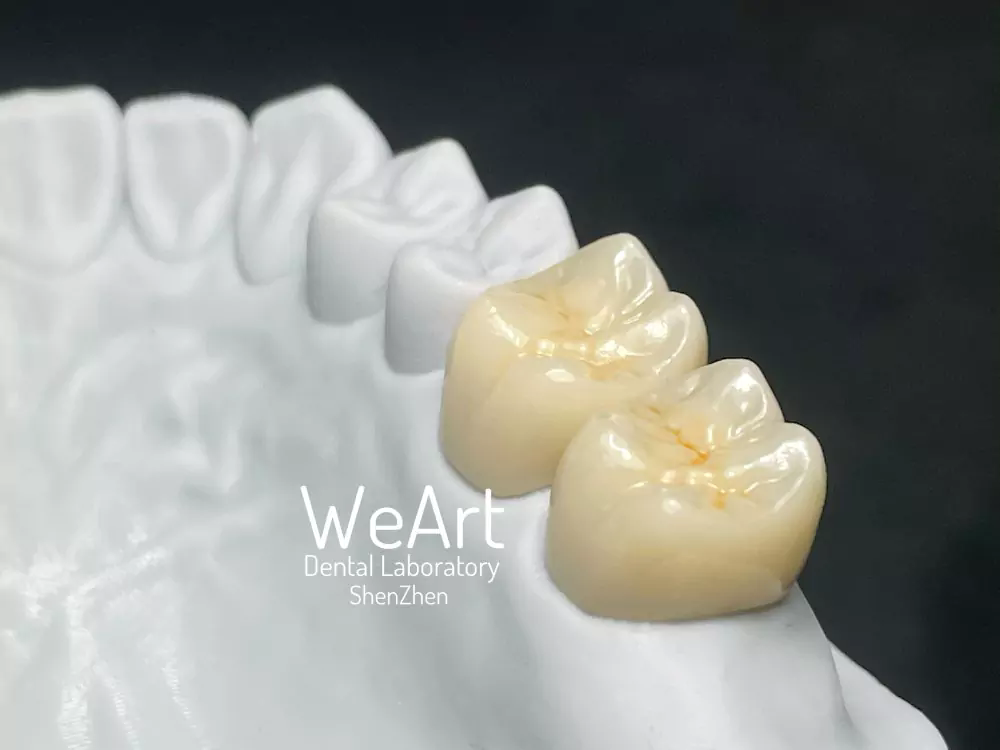Is a Full Zirconia Crown the Ideal Solution for Durable, Aesthetic Dental Restorations?
2025-10-17
A full zirconia crown is a dental prosthesis made entirely from high-strength zirconium dioxide (zirconia), offering exceptional durability, biocompatibility, and aesthetics.
What Is a Full Zirconia Crown?
A full zirconia crown is a full-coverage dental crown fabricated entirely from zirconium dioxide (ZrO₂), without a core of another material like porcelain or metal. Unlike layered crowns that combine a zirconia core with veneering porcelain, full zirconia crowns use monolithic zirconia for the entire anatomy. They are milled from pre-sintered zirconia blocks (or multilayer blocks) and then sintered to full density.
Technical Parameters and Material Specifications
Below is a table summarizing key technical parameters commonly used in high-quality full zirconia crowns:
| Parameter | Typical Value / Range | Significance |
|---|---|---|
| Flexural Strength | 900 – 1,400 MPa | Indicates resistance to fracture under bending |
| Hardness (Vickers) | ~1,200 – 1,400 HV | Correlates to wear resistance and surface durability |
| Fracture Toughness (K_IC) | ~4 – 6 MPa·m^0.5 | Resistance to crack propagation |
| Translucency (Contrast Ratio) | 0.50 – 0.65 | A lower contrast ratio means more translucency for aesthetic blending |
| Layer Thickness (minimum) | 0.5 – 0.7 mm | Minimal thickness required to maintain structural integrity |
| Sintering Temperature | ~1,450 – 1,550 °C | Final densification temperature |
| Grain Size | ~0.3 – 0.6 µm | Finer grain generally improves mechanical properties and optical behavior |
These specifications are representative of premium-grade, multi-layered zirconia materials used in modern prosthodontics.
Material Attributes and Composition
-
Zirconia is a polycrystalline ceramic, often stabilized with yttria (yttria-stabilized zirconia, YSZ) to maintain the tetragonal phase at room temperature.
-
Multi-layer zirconia blocks incorporate gradual changes in translucency and shade throughout the block to mimic natural tooth color gradients.
-
Additive dopants and doped zirconia variants (e.g., cubic phase inclusions) are used to improve translucency while retaining mechanical strength.
Given these material attributes, full zirconia crowns combine structural resilience with esthetic potential, making them suitable for both posterior and increasingly anterior restorations when properly designed and polished.
Why Choose Full Zirconia Crowns?
Advantages Over Other Crown Types
-
High Mechanical Strength and Fracture Resistance
The high flexural strength and fracture toughness values (as shown above) make full zirconia crowns highly resistant to chipping or cracking, even under heavy occlusal forces. -
Excellent Wear Behavior
When properly polished, full zirconia exhibits favorable wear properties against opposing enamel or restorations, minimizing damage to natural teeth. -
Low Chipping Risk
Because there is no veneering porcelain layer, the risk of porcelain chipping (a known issue with porcelain-fused-to-metal or layered zirconia crowns) is substantially reduced. -
Biocompatibility and Soft Tissue Response
Zirconia is well tolerated by periodontal tissues, showing low plaque accumulation and favorable gingival response compared to some metal-based restorations. -
Aesthetic Potential
Modern multi-layer and high-translucency zirconia systems allow for shade gradients and improved light diffusion, enabling visually pleasing results in many cases. -
Minimal Laboratory Margin Adjustments
Good milling precision and controlled sintering shrinkage enable accurate margins, reducing the need for manual adjustments.
Indications and Clinical Scenarios
Full zirconia crowns are particularly suitable in the following situations:
-
Posterior restorations where high masticatory load demands strength.
-
Implant-supported crowns, where thin walls and load resistance are critical.
-
Patients with parafunctional habits (e.g., bruxism) requiring durable materials.
-
Situations where a metal-free solution is preferred due to allergy or esthetic concerns.
-
As abutment restorations where minimal invasive preparation is needed.
However, for extremely high esthetic demand cases (e.g., translucent incisal edges in anterior teeth), layered or glass-ceramic crowns may still be considered. The design should ensure appropriate bulk and avoid ultra-thin walls in high-stress zones.
Current Market Trends and Future Directions
-
Increasing adoption of monolithic (non-veneered) restorations as more clinicians prefer avoiding veneer ceramic chipping.
-
Improved translucent zirconia formulations with better optical properties (e.g., partially stabilized zirconias with cubic-phase inclusions).
-
Integration with digital workflows: CAD/CAM systems, digital impression accuracy, and in-office milling are fueling faster turnaround times.
-
Nano-ceramic surface treatments and glazing technologies to enhance color depth and surface luster.
-
Custom gradient blocks that mimic natural dentin-to-enamel behavior in a single blank.
-
Artificial intelligence–assisted design tools to optimize thickness and support of high-translucency zones while preserving strength.
As these trends mature, full zirconia crowns are likely to gain even greater prevalence in restorative and implant dentistry.
How Are Full Zirconia Crowns Produced and Placed?
Workflow Steps in Fabrication and Placement
-
Diagnostic Planning and Preparation
-
Evaluate occlusion, interocclusal space, and the opposing dentition.
-
Prepare the tooth with adequate clearance for a zirconia crown, typically 0.8–1.0 mm in axial walls and 1.5–2.0 mm on occlusal surfaces, ensuring even reduction and avoiding sharp edges.
-
Finish margins (often chamfer or rounded shoulder) with smooth transition to avoid stress concentrations.
-
-
Digital Scanning / Impression Taking
-
Use an intraoral scanner or conventional impression to capture the prepared tooth and adjacent structures.
-
For digital workflows, check scan data for defects, undercuts, and margin clarity.
-
-
CAD Design
-
Design crown contours, occlusal anatomy, and margin design in CAD software.
-
Apply proper cement space settings (often 20–40 µm internal space) and confirm minimal thickness clearance, adjusting where necessary.
-
Use support structures or blocking design where required for sintering.
-
-
CAM Milling / Pre-Sintering
-
Mill the designed crown from a pre-sintered zirconia block using a 5-axis milling machine.
-
Use water cooling and precise tool paths to minimize micro-cracks.
-
-
Sintering / Densification
-
Place the milled zirconia crown in a sintering furnace, heating it gradually to ~1,450–1,550 °C following manufacturer protocols.
-
Cooling must be controlled to avoid thermal stresses.
-
-
Post-Processing, Finishing, and Characterization
-
Perform surface polishing, fine finishing, and glazing as needed.
-
Apply external stains or surface characterizations if needed for color blending.
-
Inspect margins, fit, and occlusion.
-
-
Try-In and Adjustment
-
Try the crown intraorally, verify fit, marginal integrity, and occlusal contacts.
-
Adjust minor high spots using fine diamond burs, then re-polish the adjusted areas.
-
-
Cementation / Bonding
-
Clean and possibly air-particle-abrasion internal surfaces.
-
Use a suitable adhesive resin cement or traditional cement, following isolation protocols.
-
Remove excess cement and light cure or allow self-cure. Confirm final contacts and occlusion.
-
Best Practices and Key Considerations
-
Maintain minimum recommended wall thickness to avoid structural weakness.
-
Avoid sharp internal angles—round transitions help reduce stress concentration.
-
Use proper cement space design to balance retention and fit.
-
Be cautious with adjustments—excessive grinding may introduce micro-cracks; always re-polish.
-
Monitor occlusal scheme and ensure no premature contacts; full zirconia can transmit forces to adjacent structures.
-
When used in the esthetic zone, confirm shade matching under different lighting conditions and possibly use cut-back plus veneering in rare cases.
Challenges and Mitigation Strategies
| Challenge | Mitigation Strategy |
|---|---|
| Brittleness at thin sections | Avoid ultra-thin walls, ensure minimal thickness zones |
| Adjustments causing micro-cracks | Limit grinding, finish with polishers and glazing |
| Color limitations in translucent zones | Use gradient zirconia blocks or external staining |
| Chipping of adjacent teeth | Polish opposing surfaces and monitor occlusal forces |
| Marginal misfit | Careful CAD margin design and calibration of milling machines |
By following a precise digital and laboratory workflow, full zirconia crowns can be reliably produced with excellent fit, aesthetics, and longevity.
Questions and Answers on Full Zirconia Crowns
Q1: Is full zirconia crown suitable for front (anterior) teeth?
A1: Yes, full zirconia crowns can be used in anterior teeth, but with caution. Modern high-translucency zirconia and gradient blocks allow good aesthetics; however, for extremely demanding cases (e.g., super-translucent incisal edges), additional techniques (such as minimal veneer layering on the facial surface) may still be considered. It is critical to respect proper thicknesses, avoid thin facial walls, and perform shade matching under different lighting conditions.
Q2: How long does a full zirconia crown last compared to traditional crowns?
A2: When properly designed, fabricated, and maintained, full zirconia crowns commonly provide 10–15 years or more of service, often outperforming other crown types in terms of resistance to chipping or fracturing. Long-term studies indicate excellent survival rates in posterior and implant restorations, with less risk of veneer delamination or marginal degradation.
Future Prospects, Market Positioning, and Strategic Implementation
Emerging Developments and Innovations
-
Next-generation translucent zirconia: Manufacturers are pushing the limits of translucency through innovative composite crystal structures (e.g., higher cubic-phase content) without too much sacrifice to strength.
-
Smart zirconia surfaces: Surface treatments with antibacterial, wear-resistant, or self-cleaning coatings may be added to crowns.
-
AI-driven design optimization: Automated algorithms can optimize wall thickness, support geometry, and occlusal contours to maximize both strength and realism.
-
On-site chairside fabrication: Advances in compact sintering furnaces and faster milling may enable full zirconia crowns to be delivered in a single visit.
-
Material hybrids: Combining zirconia with nano-glass infiltration or gradient glass regions may merge strength and optical properties.
Market Positioning and Competitive Advantages
Full zirconia crowns occupy a strong niche as a metal-free, durable, and cost-effective option with fewer complications than veneered systems. When marketed appropriately, they can attract:
-
Patients seeking “long-lasting, natural-looking, metal-free” restorations.
-
Dental practices emphasizing digital workflows (CAD/CAM, in-office milling).
-
Implantologists and prosthodontists needing strong abutment crowns.
-
Cases where insurance or budget constraints favor monolithic solutions.
Strategic Recommendations for Adoption
-
Educate clinicians and patients with comparative case studies showing longevity and outcomes.
-
Partner with labs that provide high-quality materials and strict QC to avoid misfits or defects.
-
Support dentists with shade-matching guides, finishing protocols, and training.
-
Offer guarantees or warranties on full zirconia crowns to build confidence.
-
Keep content updated with new material releases, research data, and clinical studies to attract organic traffic.
In summary, a full zirconia crown represents a powerful, modern solution for durable, aesthetic dental restorations. With appropriate design, material selection, and workflow, it delivers strength, biocompatibility, and increasingly natural appearance. Weart provides high-grade full zirconia crowns backed by rigorous quality control and ongoing innovation. For more information or inquiries, contact us today to explore how Weart’s full zirconia solutions can benefit your practice or patients.



